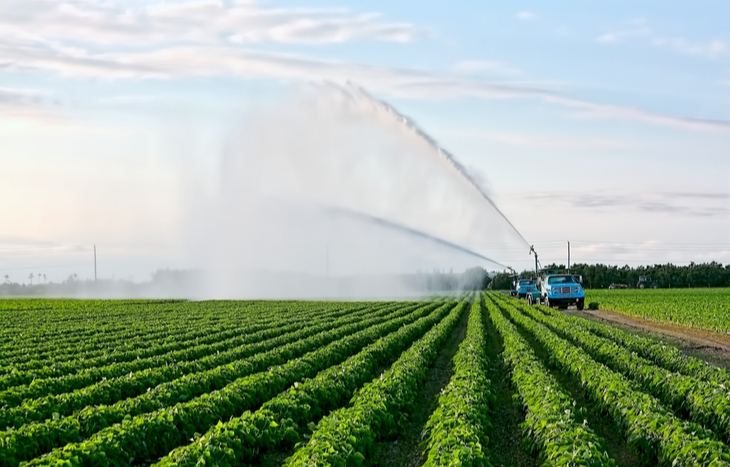Water Futures: A New Way to Invest in the Essence of Life
CME Group, formerly the Chicago Mercantile Exchange, recently added water futures to its list of contracts available to trade. This is big news because water has never been traded like this before. Prior to this development, buying and selling water rights took place on the spot market.

This makes water – at least in the eyes of Wall Street – a commodity just like gold, oil and lean hog. The commodity started trading for $496 per acre-foot. Feelings on the commodification of this human necessity have been mixed.
“As clean, usable water is becoming scarcer, the incentives in capitalism work to commodify it, and work to ensure that the scarcity is an opportunity to make money,” Basav Sen of the Institute for Policy Studies told Earther in an interview.
On the other hand, economist Steve H. Hanke pointed out in National Review that...
“Sharp fluctuations in water supply and demand can now be offset by ‘insurance policies’ offered by the new futures contracts. This innovative insurance will lower the cost of producing agricultural products – a win for farmers and a win for consumers.”
Regardless of opinions, water futures are now tradable. Water scarcity will require some people to pay more and will make money for others, as Sen said. And that’s always been the case. Farmers pay a premium for water during dry years. This leads to high prices for the consumer and uncertainty for the farmers.
If things go according to plan, this new development could have a stabilizing impact on the otherwise ambiguous marketplace of water for crops. But as this is a new development, it’ll be years before we actually know if things shake out that way.
How Water Futures Work
CME Group launched the country’s first water market with $1.1 billion in contracts. Contracts are tied to the Nasdaq Veles California Water Index. This index acts as the spot price for an acre-foot of water. Its CME ticker is NQH2O.
These futures contracts are an agreement between buyer and seller to swap water in exchange for a set price at a predetermined date in the future. But in this case, it will be a completely cash-based transaction. Nobody involved will have ten acre-feet of water delivered to them. And each contract will have a quarterly duration – so it will be settled in three months’ time.
Let’s say there is a contract for NQH2O at $500 that expires in three months. If heavy rainfall takes place, this can drive down the spot price. And if the price is still lower when the contract expires, the buyer of the contract will be required to pay the difference between the current price and the agreed-upon price.
On the other hand, if the spot price of NQH2O has risen above the agreed-upon price when the contract expires, the seller pays the buyer the difference. For the average investor, this is pretty much a crapshoot. In the early months of trading, the odds of a winning trade will probably be as favorable as in blackjack, baccarat, or, well, craps.
But gambling aside, water futures will also allow farmers and municipalities to hedge their bets on the future price of water… or even the availability of water in Western states. In this new marketplace, those who need to buy extra water when prices are high can now bet on futures contracts to offset higher prices in the future.
How It Could Go Sideways
This new futures market has the potential to draw speculators with deep pockets and lots of power. And when lots of money is on the line, it can induce some truly nefarious behavior.
Imagine a well-connected investor betting on drought and a raised NQH2O spot price. If they had the means to temporarily limit access to water and its distribution, it could artificially increase the spot price… and make the immoral investor a good chunk of change. These manipulations could also have damaging effects on crops and the price of food.
While unlikely, this scenario isn’t without precedent. Similar schemes have been seen in Australia. But for now, this is merely a hyperbolic conspiracy in the U.S.
The Bottom Line on Water Futures
The agriculture sector is the largest buyer of water in California during dry years. And water shortages have only been exacerbated as the thirsty practices of almond growing and pistachio growing have become more widespread.
The sellers are the districts in other areas with a surplus of water. And now that there’s a futures market, farmers will be able to look to the past for price developments. This can be an extremely useful tool to hedge against rising prices in the months they know they will need the most water.
Farmers know their land better than anybody else. Plus, they’ve already been forced to prepare for shortages and learn the complexities of the public market when they need more water. These factors put farmers in a position to understand water futures contracts better than anyone else… and to protect themselves from outsized increases in water prices. So when it comes to water futures, follow the farmers. They’re practically insiders.
Not the Market You’re Looking For?
If water futures don’t seem up your alley, there are plenty of other investment opportunities out there. If investing in emerging, breakthrough or disruptive trends is more your style, we suggest signing up for the Profit Trends e-letter below. It’s a free and simple way to get early insight into the emerging trends with the most upside potential.
About Matthew Makowski
Matthew Makowski is a senior research analyst and writer at Investment U. He has been studying and writing about the markets for 20 years. Equally comfortable identifying value stocks as he is discounts in the crypto markets, Matthew began mining Bitcoin in 2011 and has since honed his focus on the cryptocurrency markets as a whole. He is a graduate of Rutgers University and lives in Colorado with his dogs Dorito and Pretzel.





